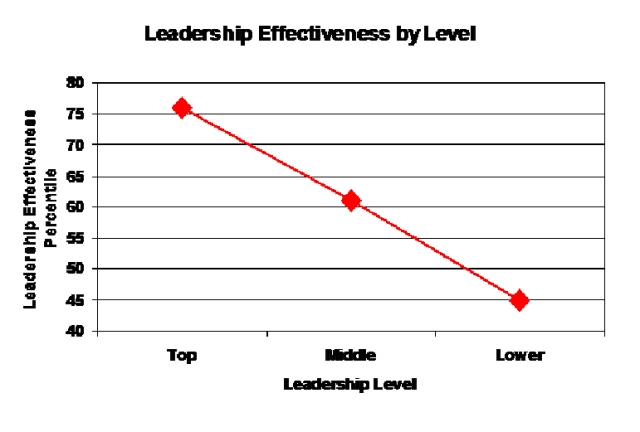The Leadership Ceiling: How Leaders Can Build Up or Bring Down an Organization
The probability is high that a leader will be less effective than their boss. There are exceptions to this rule, but the trend is very clear.
In a study of 5,285 leaders from 5 different organizations, we examined the effectiveness of leaders at different levels of the organization. The measure of leadership effectiveness was derived from our research on Extraordinary Leaders. In that research we identified 16 competencies that best explained the differences between poor, good and great leaders. 49 items are used to measure the 16 competencies where assessments are completed by a leader’s manager, peers, direct reports and others. Results from each organization were examined and the graph below shows the average difference by level.
 When we look at the results, leaders at the top of an organization tend to be rated as more effective than their direct reports and their direct reports tend to be rated as more effective than their direct reports.
When we look at the results, leaders at the top of an organization tend to be rated as more effective than their direct reports and their direct reports tend to be rated as more effective than their direct reports.
Leadership Impacts Outcomes
In extensive studies we have demonstrated the clear connection between the effectiveness of a leader and a variety of organizational outcomes. Great leaders create more profit, higher customer satisfaction, high levels of engagement in their employees, lower turnover and substantially more highly committed employees.
While talking with a group of leaders recently, the question was asked, “How many great leaders do you need in order for an organization to be successful?” One of the leaders commented, “At least one!” While it’s true that one is much better than none, our data clearly shows that the influence of a leader is significantly diminished from one level of the organization to the next. In fact, the influence of a person’s direct manager will always overpower the effectiveness of another leader in the organization. The correct answer to “How many great leaders are needed,” is that they all need to be effective. Poor leadership at any level of the organization will have a very negative impact.
High Ceilings
In many organizations, there is an assumption that the top management group does not need much development. While it is true that senior leaders tend to be more effective, executive leaders in our study ranged from the 68th percentile (a little above average) to the 93rd percentile (extraordinary). Thus, not all top management is at the top of leadership effectiveness.
Between each tier of management, a leadership effectiveness “gap” exists. The higher tier of management usually has a higher level of leadership effectiveness. The average gap 14.5 percentile points. Using that as an average metric, if an organization wanted leaders in the 4th tier down to be at the 50th percentile (just average) the top level of leaders would need to be at the 94th percentile in terms of the average leadership effectiveness. Keep in mind that these leaders establish the height of the ceiling. If their average effectiveness is at the 68th percentile then the next level will be on average 14.5 percentile points lower.
Top management sets the example for the rest of the organization. In the organizations we have studied, those who have the best leaders always have top management groups fully engaged and participating in leadership development programs. Those with lower levels of leadership effectiveness assume that the top leaders are “good enough.”
Reducing the Gap
When looking at the differences between levels, not every gap was large. Some organizations only had gaps of 3 to 5 percentile points. This small gap created a dramatic shift upward in the effectiveness of leaders. It became apparent that the small gap was a function of several issues.
The first issue was selecting the right people as leaders. When filling various job positions, organizations that analyzed how, rather than what, results were achieved selected more effective leaders. These talent management processes also emphasized a clear set of desirable leadership competencies and created a common language around those competencies.
Second, the top manager of the organization believed that a significant part of the job was the development of their direct reports. They felt it was their responsibility and not a Training or HR responsibility. Because of this belief, feedback was frequent; training was welcomed and encouraged.
Third, the direct reports of the senior leader felt the same way about their direct reports. In the organization there was a strong emphasis on development of every employee. Fourth, the bar for effective leadership was set high. The expectation was the leaders needed to be great and not just good.
Cup Half Full or Half Empty
There are two ways to look at this research. The “half empty” view is that leaders are typically less effective than their bosses. This view focuses on the tendency of leaders to hold people back from realizing their potential. The “half full” view is that the more effective a person is as a leader the more effective their direct reports will be. There is a very positive message from this that leaders can pull up the effectiveness of others in the organization. A good example has a very positive effect in any organization. If you desire great leadership in your organization, then be committed to set your own bar high and be willing to look for ways to improve. The quickest and easiest path to improvement comes from getting focused feedback and then looking for opportunities to build on existing strengths
Joe Folkman – President and Co-founder
 Want more research on leadership effectiveness? Get free access in our Leadership Resource Center! Sign Up Now
Want more research on leadership effectiveness? Get free access in our Leadership Resource Center! Sign Up Now
